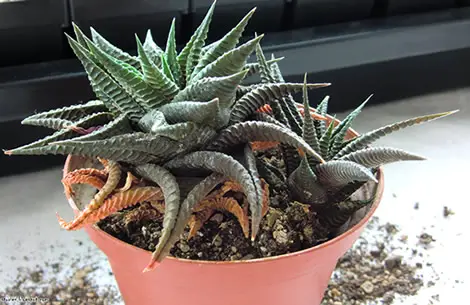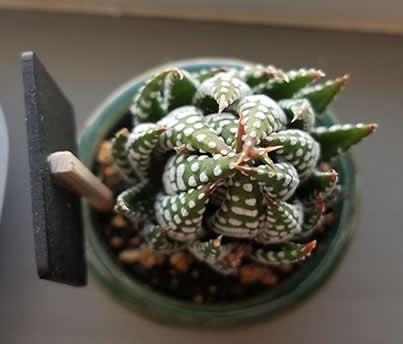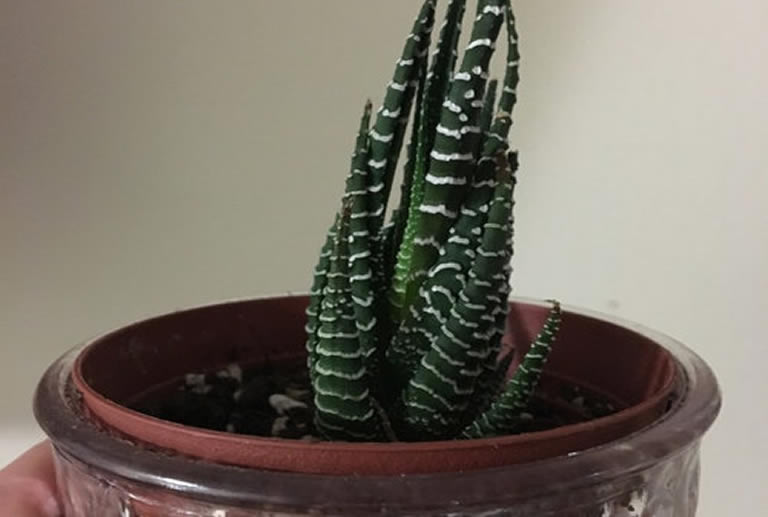Plenty of plant lovers are fascinated by the zebra plant, as it makes a lovely indoor houseplant and the Haworthia is certainly special compared to many other species. But, the unique nature of this little plant means that its care needs particular consideration to ensure its continued health.
Table of Contents
- Why Does A Haworthia Begin Closing Up?
- 5 Reasons why Haworthia plants close up
- 1. Haworthia require balanced sunlight exposure to avoid the foliage closing over
- 2. Haworthia react poorly and will close up when subjected to adverse temperatures
- 3. Improper soil can also be a cause for a Haworthia closing up
- 4. The wrong pot can also lead to Haworthia closing up
- 5. Haworthia reacts poorly to incorrect water supply & will close up (biggest reason)
- How To Revive A Haworthia That Seems To Be Dying
Why Does A Haworthia Begin Closing Up?
Haworthia plants may close up if they are dehydrated.
They can also close up if they overheat.
Overwatering also causes a Hawthoria to close up. This can be due to a poor water routine or a container that does not allow drainage or air circulation for the roots.
Unsuitable soil type with incorrect nutrient content may also lead to curled-up leaves and a closing of the plant.

Haworthia plant come in 16 different varieties. All varieties have the same basic care needs.
Haworthia can show signs of discomfort in various ways, but one of the most common indicates of discomfort is when the plant closes itself up.
Join us as we discuss the needs of Haworthia plants, potential reasons why they may close up, as well as how to go about establishing a practical and effective care routine to avoid this happening.
A quick background on the Haworthia
Haworthia plants, commonly known as zebra plants, are relatively straightforward to care for, whether indoors or outdoors.
Haworthia is a small succulent plant that originates from South Africa.
Haworthia are a popular household plant since they are low-maintenance, and their visual appeal provides a unique element to any area’s aesthetic.
They are often seen on window ledges were in areas where they can get plenty of sunlight.
Be aware though, that this plant can have very adverse effects on pets, especially cats (as I pointed out in the article are Madagascar Palms poisonous).
So, if you have a house with a pet be sure to read this article to ensure you protect your furry family members.
5 Reasons why Haworthia plants close up
The Haworthia plant species will close up if there are undesirable elements within their environment or if your care plan is lacking.
The main reasons for Haworthia closing up are due to incorrect quantities of water, incorrect exposure to sunlight, and exposure to adverse temperatures.
These elements can cause the plant to become stressed and close up. Let’s take a look at each of these causes in closer detail.
1. Haworthia require balanced sunlight exposure to avoid the foliage closing over
Haworthia plants, like all succulents, need sunlight.
However, they will be harmed by excessively high temperatures and/or excessive sunlight exposure.
Indirect exposure to sunlight or bright light is best for these plants, and they may begin to close up as a protective measure if they are exposed to too much direct sunlight.
This cause for a Haworthia closing up can be accompanied by curled leaves. The leaves may turn red, white, or yellow.
Sometimes it is easy to think the problem is caused by underwatering when in fact it is too much direct strong and hot sunlight.
2. Haworthia react poorly and will close up when subjected to adverse temperatures
The temperature if the environment in which your Haworthia is growing can also play a key role in why they may be closing up.
The plant stems may curl up if they are overheating and if this is the case the plant will close for protection against the heat.

The ideal temperature range for this plant species is 65°F – 75°F.
Fortunately, this temperature range is typical in many households thus making this an ideal houseplant.
3. Improper soil can also be a cause for a Haworthia closing up
The soil in which the plant sits can also affect it and cause it to close its stems.
Soil should be less dense and dry for best comfort of this succulent.
Soil type and pH levels are important for Haworthia
Using the correct soil is essential.
Soil type can not only affect the feeding of the plant but it can also influence the water retention, drainage, and thirst levels of the Haworthia plant, especially indoors.
The soil you use should be porous cactus or a good quality succulent potting mix, which is less dense and drier than normal potting soils.
This soil type allows the plant’s roots to retain their health and condition and encourages airflow to the roots.
The pH content of the soil should be neutral, ranging from 6.6 – 7.5.
4. The wrong pot can also lead to Haworthia closing up
The pot containing the plant can also cause some issues since it should allow for proper drainage and air circulation for the roots.
These causes are less common but can be identified through observation over a week if the more common causes can be ruled out after you have taken appropriate action on them.
Indoor Haworthia need pots or containers with good drainage
Drainage is essential for the health of Haworthia roots, as they need plenty of air and should be kept free from water buildup.
You should ensure sufficient airflow and drainage ins offered by the container type you choose for your plant.
When repotting it is a good ideas to go for a container that is wider than the original as this will support the revival process.
You may need to trim dead leaves if there is root damage, as this will assist in allowing the plant to provide nourishment to all of its parts.
You may need to experiment with placement during the process. Clean the leaves and feed the plant if it is spring or summer.
5. Haworthia reacts poorly to incorrect water supply & will close up (biggest reason)
The water supply is often one of the most common causes for the Haworthia closing up.
As a succulent the plant is very susceptible to changes in its ideal watering routine.
When Haworthia are underwatered and become dehydrated, they become stressed and will usually close up.

However they react similarly when they are overwatered.
The Haworthia can also become stressed and close when they are overwatered.
Succulents grow naturally in water spare areas and overwatering the plant will stress it.
You can tell the difference between an underwatered Haworthia and an overwatered one because dehydration is commonly accompanied by curled-up leaves and/or stems that are turning red.
How to water Haworthia the right way
Watering succulents is a cause of concern for most plant lovers.
Being mostly desert plants many succulent owners are concerned about the amount of water they should give to their plants … and rightly so!
Haworthia react badly to both underwatering and overwatering so it is important to get your watering routine right.
Luckily, watering all Haworthia plants is relatively straightforward.
Your plant should be watered according to its individual sun exposure and environmental temperatures following the guidelines given below.
However, before you look at the ideal watering routine for Haworthia be aware that you should avoid getting water onto the leaves and you must also avoid deep watering.
As a succulent Haworthia do love a nice drink of water but overwatering them, as we have already seen, leads to just as much problems as underwatering them.
The soil should be allowed to dry in between watering sessions since the roots should not remain wet over time.
How often to water Haworthia
The amount of water necessitated by your Haworthia will depend on a few factors, most of which involve exposure to sunlight and environmental temperatures.
In higher temperatures with higher exposure to sunlight, the plant may need more water to avoid dehydration.
Haworthia plants will need less water in cooler temperatures with less exposure to sunlight that evaporates the water in the soil.
Indoor Haworthia watering routine
As a rule-of-thumb although the top layer of soil to almost dry out before watering the plant. Do not allow the soil to completely dry.
When the top layer dries the lower layers will still contain moisture, enough to ensure the roots get enough and Haworthia retains water in its leaves as well.
So, placing your finger into the soil should allow you to determine how dry it is. Moist soil ill leave soil residue on your finger while dry soil won’t.
If your finger comes out dry your plant is being underwatered while if it comes out caked with soil you’re probably overwatering.
As I say, when the top layer of soil dries out it’s time to water the plant.
Outdoor Haworthia watering routine
Haworthia plants can survive for a long time without water, a classic characteristic of succulent plant species. After all they grow in warm dry places.
Watering in warm climates and high sun exposure
If your Haworthia are grown in warmer climate zones or are placed outdoors in environments with a higher level of indirect sunlight exposure, they will benefit from being watered at least once every 1 – 2 weeks.
If they get more direct sunlight (which you should really avoid) they will require watering much more often.
This provision of water will ensure that the plant does not become dehydrated and allow you to avoid overwatering it at the same time.
Watering in cool climates and low sun exposure
When grown in cooler climate zones with colder weather, or when placed indoors with less exposure to indirect sunlight, the Haworthia will demand much less water than in warmer conditions.

You will need to ensure that you do not overwater your Haworthia in such situations, as any water provided will last longer when there is less heat and lower levels of sunlight.
Watering your plants once every 2 – 3 weeks or as needed should suffice in such cases.
Why you should avoid overwatering Haworthia
Haworthia plants benefit from a thorough watering session as needed.
But, they should never be overwatered since their roots should remain relatively dry, contrary to many other household plants.
Too much water supply will damage the plant’s roots, causing them to melt or whither causing dehydration and nutrient deficiency in the rest of the plant.
This dismal effect will severely impact their ability to absorb water from the soil, which is incredibly detrimental to plant health.
Too much water supplied directly onto the extremities of the plant, such as the stems, can also cause them harm, as their leaves are susceptible to rotting when they are too moist.
Although it may be disheartening to witness your beloved Haworthia becoming stressed and closing up, the causes for this behavior are relatively common, and most cases are not severe.
The fixes are also relatively simple and if you take immediate action the likelihood is that your plant will not only survive but will thrive once you get its care routine sorted out correctly.
How To Revive A Haworthia That Seems To Be Dying
What can you do when your Haworthia starts closing up or when it looks like it’s dying … how can you revive the plant?
To revive a Haworthia you need to move it to a more shaded area that gets light but is away from strong direct sunlight.
Feed with an appropriate fertilizer and check you are using the right soil with the correct pH levels.
Ensure the plant’s container has sufficient drainage and recheck your watering routine.
If necessary, and if the plant is not in serious distress, consider repotting it in a large container.
This plant species may be revived by ensuring a suitable environment for them.
Move the plant immediately from where it is to a more ideal spot that gets plenty of light but not to much prolonged direct sunlight.
If need be move the plant to a more shaded are to see if it responds positively.
Double check your watering routine.
Have you been overwatering or underwatering the plant?
Does your Haworthia needed repotted with the correct soil? Be very careful before you go down this route as weak plants are often traumatized by repotting.
If you feel that the soil is insufficient for your plant’s needs try a little fertilizer first to see if it responds positively before repotting.
Restoring this plant typically takes a few weeks when done properly.

